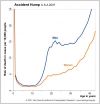(Press-News.org) Researchers at Lund University have discovered a new function for vitamin C. Treatment with vitamin C can dissolve the toxic protein aggregates that build up in the brain in Alzheimer's disease. The research findings are now being presented in the Journal of Biological Chemistry.
The brains of people with Alzheimer's disease contain lumps of so-called amyloid plaques which consist of misfolded protein aggregates. They cause nerve cell death in the brain and the first nerves to be attacked are the ones in the brain's memory centre.
"When we treated brain tissue from mice suffering from Alzheimer's disease with vitamin C, we could see that the toxic protein aggregates were dissolved. Our results show a previously unknown model for how vitamin C affects the amyloid plaques", says Katrin Mani, reader in Molecular Medicine at Lund University.
"Another interesting finding is that the useful vitamin C does not need to come from fresh fruit. In our experiments, we show that the vitamin C can also be absorbed in larger quantities in the form of dehydroascorbic acid from juice that has been kept overnight in a refrigerator, for example".
There is at present no treatment that cures Alzheimer's disease, but the research is aimed at treatments and methods to delay and alleviate the progression of the disease by addressing the symptoms.
That antioxidants such as vitamin C have a protective effect against a number of diseases, from the common cold to heart attacks and dementia, has long been a current focus of research.
"The notion that vitamin C can have a positive effect on Alzheimer's disease is controversial, but our results open up new opportunities for research into Alzheimer's and the possibilities offered by vitamin C", says Katrin Mani.
###
Contact:
Katrin Mani, MD, PhD, Reader, tel: 046-2224077, mobile: 070-2958622, email: katrin.mani@med.lu.se
Article:
Suppression of amyloid beta A11-immunoreactivity by vitamin C: possible role of heparan sulfate oligosaccharides derived from glypican-1 by ascorbate-induced, NO-catalyzed degradation.
Fang Cheng, Roberto Cappai, G.D. Ciccotosto, Gabriel Svensson, Gerd Multhaup, Lars-Åke Fransson and Katrin Mani. Journal of Biological Chemistry, 286, 27559-27572, 2011.
Link: http://www.jbc.org/content/286/31/27559.abstract?sid=c8bfe2f0-2f4b-4294-b0f9-c9f0445972af
Treatment with vitamin C dissolves toxic protein aggregates in Alzheimer's disease
2011-08-19
ELSE PRESS RELEASES FROM THIS DATE:
Are those liquids explosive?
2011-08-19
A team of researchers from the University of the Basque Country (Spain) has developed a method to determine the chemical composition of liquids seized by police and suspected to be explosive. Some of the samples analysed contained substances hazardous to health, such as methanol and boric acid.
Each year police forces seize tonnes of pyrotechnic substances which, in principle, are for indoor firework manufacturing (i.e. flares or those used in artistic or sporting events), but which also may end up in the hands of violent groups and hooligans.
A group of chemists from ...
Revealed: How sticky egg captures sperm
2011-08-19
Researchers have uncovered exactly how a human egg captures an incoming sperm to begin the fertilisation process, in a new study published this week in the journal Science.
The research identifies the sugar molecule that makes the outer coat of the egg 'sticky', which is vital for enabling the sperm and egg to bind together. Researchers across the world have been trying to understand what performs this task for over thirty years.
The scientists behind this study believe their work could help address some of the previously unexplained causes of human infertility and ...
CSHL neuroscientists show activity patterns in fly brain are optimized for memory storage
2011-08-19
Large-scale imaging shows mushroom body activity patterns are sparse and randomly distributed Cold Spring Harbor, NY – We know from experience that particular smells are almost inseparable in our minds with memories, some vague and others very specific. The smell of just-baked bread may trigger an involuntary mental journey, even if for a moment, to childhood, or to a particular day during childhood. Or it may, more diffusely, remind someone of grandma. How are these associations forged in the brain and how do we remember them? A research team at Cold Spring Harbor ...
Boys reach sexual maturity younger and younger
2011-08-19
This release is available in German.
Boys are maturing physically earlier than ever before. The age of sexual maturity has been decreasing by about 2.5 months each decade at least since the middle of the 18th century. Joshua Goldstein, director of the Max Planck Institute for Demographic Research in Rostock (MPIDR), has used mortality data to prove this trend, which until now was difficult to decipher. What had already been established for girls now seems to also be true for boys: the time period during which young people are sexually mature but socially not yet considered ...
Study raises doubts about value of heart ultrasound before elective surgery
2011-08-19
TORONTO, Ont., Aug. 18, 2011_A new study has found no evidence that patients who had a heart ultrasound known as an echocardiogram before major surgery had improved survival rates one month or one year after their operation.
Some groups of patients actually had worse survival rates, according to Dr. Duminda Wijeysundera, a scientist at the Li Ka Shing Knowledge Institute of St. Michael's Hospital and the Institute for Clinical Evaluative Sciences.
His study, published in the British Medical Journal, adds to a growing body of evidence that echocardiograms may not be ...
UGA physicist helps uncover new data on adenine, a crucial building block of life
2011-08-19
Athens, Ga. – Early Earth's atmosphere provided little shielding for ultraviolet light from space, so many prebiotic molecules, bombarded by it and light of other wavelengths, had a hard time surviving at all. But some molecules became photostable—able to withstand the assault and thrive as building blocks of life.
Five of the many molecules that survived the bombardment from UV light were the nucleic acid bases adenine, cytosine, guanine, thymine and uracil. Now, in just published research, a University of Georgia physicist and a collaborator in Germany have shown that ...
Study finds sex differences in mental illness
2011-08-19
WASHINGTON – When it comes to mental illness, the sexes are different: Women are more likely to be diagnosed with anxiety or depression, while men tend toward substance abuse or antisocial disorders, according to a new study published by the American Psychological Association.
Published online in APA's Journal of Abnormal Psychology, the study looked at the prevalence by gender of different types of common mental illnesses. The researchers also found that women with anxiety disorders are more likely to internalize emotions, which typically results in withdrawal, loneliness ...
Embryo development obeys the laws of hydrodynamics
2011-08-19
Vincent Fleury, a researcher at the Paris Diderot University, studied the early stage of development when embryonic cells first form a flat sheet of cells before folding into a U-shape, resembling a folded pancake. He demonstrated that the formation of a chicken's head is a consequence of the collision between both sides of the embryo flowing at constant speed towards each other.
This study captured for the first time on film highly accurate observations of how a chicken embryo evolves during its first two days of development, using time-lapse microscopy. Prior attempts ...
A quick way to grade grasses for ethanol yields
2011-08-19
This release is available in Spanish.
U.S. Department of Agriculture (USDA) researchers have developed an inexpensive way to grade the ethanol potential of perennial grasses at the biorefinery's loading dock.
That future has been made possible by a team of Agricultural Research Service (ARS) scientists, including Ken Vogel, Rob Mitchell, and Steve Masterson at Lincoln, Neb.; Hans Jung at St. Paul, Minn.; Bruce Dien at Peoria, Ill.; and Michael Casler at Madison, Wis. ARS is USDA's chief intramural scientific research agency, and this research supports the USDA priority ...
Headaches are common in year following traumatic brain injury, especially among females
2011-08-19
New Rochelle, NY, August 18, 2011—Recurring headaches are common during the year following a traumatic brain injury (TBI), regardless of the severity of the TBI, and they tend to occur more often among females and those with a pre-TBI history of headache, according to an article in Journal of Neurotrauma, a peer-reviewed journal published by Mary Ann Liebert, Inc. The article is available free online at www.liebertpub.com/neu
More than 70% of patients who had suffered a TBI reported having headaches during the first year after their injury. This finding is a result of ...


